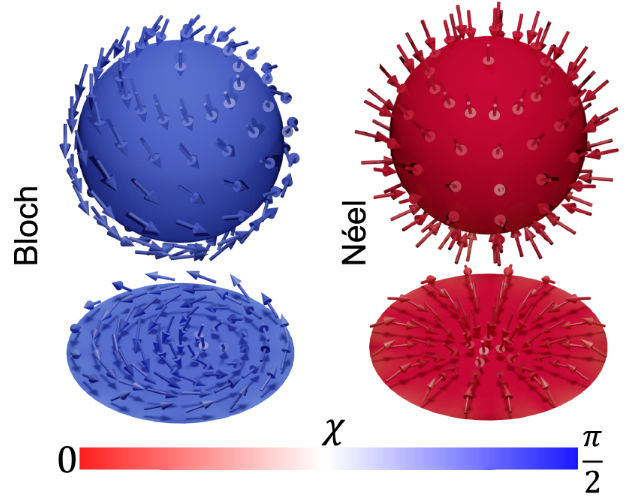Skyrmion metamorphosis: A Breakthrough in Magnonic Crystal Research
Magnetic skyrmions, with their distinctive vortex-like magnetic spin configurations, have emerged as a fascinating subject of study, capturing the attention of researchers worldwide. A recent breakthrough in the study of skyrmions has been achieved through neutron scattering techniques, revealing the presence of hybrid skyrmion phases in the polar tetragonal magnet EuNiGe3.
This discovery, by a collaboration of researchers (Paul Scherrer Institute, the Insitut Laue-Langevin, The University of Tokyo, Hokkaido University, RIKEN Center for Emergent Matter Science, and Helmholtz-Zentrum Berlin) marks a significant advancement in the field of topological magnetic phases and potential applications such as magnonic crystals .
As researchers continue to understand, explore and manipulate the properties of these unique magnetic structures, the potential for advances in signal processing and communication devices based on reconfigurable skyrmion-based magnonic crystals becomes increasingly promising.
Traditionally, magnetic skyrmions have been known to form two-dimensional hexagonal close-packed lattices, displaying either Bloch- or Néel-type internal magnetization textures. While recent theories suggested the possibility of reconfigurable transitions between different skyrmion phases and internal textures, supporting experimental evidence remained scarce.
However, recent groundbreaking research has uncovered the existence of hybrid skyrmion phases in EuNiGe3, each exhibiting distinctive internal textures characterized by a combination of Bloch- and Néel-type windings.
Read 'Analysis of cosmic dust brings scientists one step closer to quantum and magnonic devices', a previous study about the excitations of the skyrmion lattice (which was of the Bloch type in this case).
A remarkable aspect of this discovery is the direct transition between the two hybrid skyrmion phases, triggered by the variation of a magnetic field, and coinciding with a hexagonal-to-square skyrmion lattice transformation. The comprehensive theoretical analysis attributes this metamorphosis to a competition between different types of spin alignment tendencies within the material.
A second key aspect is precisely how the magnetic skyrmion lattices are arranged inside the host crystal lattice. Uniquely in EuNiGe3, the skyrmion lattices prefer to align with directions that do not match high symmetry directions of the host crystal lattice. This reduced-symmetry alignment of skyrmions in the crystal facilitates the competition of interactions promoting both Bloch- and Néel-type textures simultaneously. The stability of hybrid skyrmions emerges as a compromise spin texture in the face of these competing interactions.
The world-leading capabilities of the D33 instrument at the ILL were essential for the neutron scattering measurements reported in the study. Indeed, D33 stands out as the only SANS instrument in the world that provides both high magnetic fields and full neutron spin polarization analysis, meeting essential criteria for measuring in real time the transition between the two hybrid skyrmion phases as an immediate response to the variation of the magnetic field.
By providing key experimental evidence for skyrmion lattice transitions, this study underpins a future strategy for realizing hybrid skyrmion formation in bulk materials. This breakthrough holds profound implications for the exploration and control of topological magnetic phases, paving the way for potential technological applications.
Reconfigurable skyrmion-based magnonic crystals, in particular, offer exciting possibilities for signal processing and communication. These periodic arrangements of magnetic skyrmions can control magnons, the collective oscillations of magnetic moments in a material. By varying the magnetic field, researchers could therefore switch between different magnon-flow settings, making such crystals valuable for the development of magnonic devices.

The skyrmion lattices are like lattices of magnetic tubes. (see illustration here (png - 746 Ki))
The 2D disk represents the cross-section of the tube. The arrows plotted on the disc denote the local direction of the magnetisation (i.e. spins), while the colours of the disc denote a quantity called the helicity, which describes the way the magnetisation (spins) twists locally as you go across the skyrmion.
For conventional skyrmions, as shown above, the helicity is constant and so the discs are homogenously colored.

For the skyrmions found in this study, the so-called hybrid skyrmions, the helicity varies across the skyrmion - as shown by the non-homogeneous colour code.
This was another important finding - along with the skyrmion lattice transition.
A 3D sphere representation can be used to describe if a magnetic structure is topological in nature.
For all the spins on the disc, the various different directions they point in correspond to different points on the surface of the sphere. For skyrmions, there are enough arrows pointing in different directions to fully cover the sphere. This makes the magnetic object topological.
In contrast, if you have a simple ferromagnet, where all the arrows would point in the same direction, you would only have one arrow on the north pole of the sphere, and so the magnetic structure is not topological.
ILL Instrument: D33, the Massive dynamic q-range small-angle diffractometer
Reference: Transition between distinct hybrid skyrmion textures through their hexagonal-to-square crystal transformation in a polar magnet, https://doi.org/10.1038/s41467-023-43814-x [Open Access]
ILL Contact: Robert Cubitt
Contact:White Jonathan (PSI)
